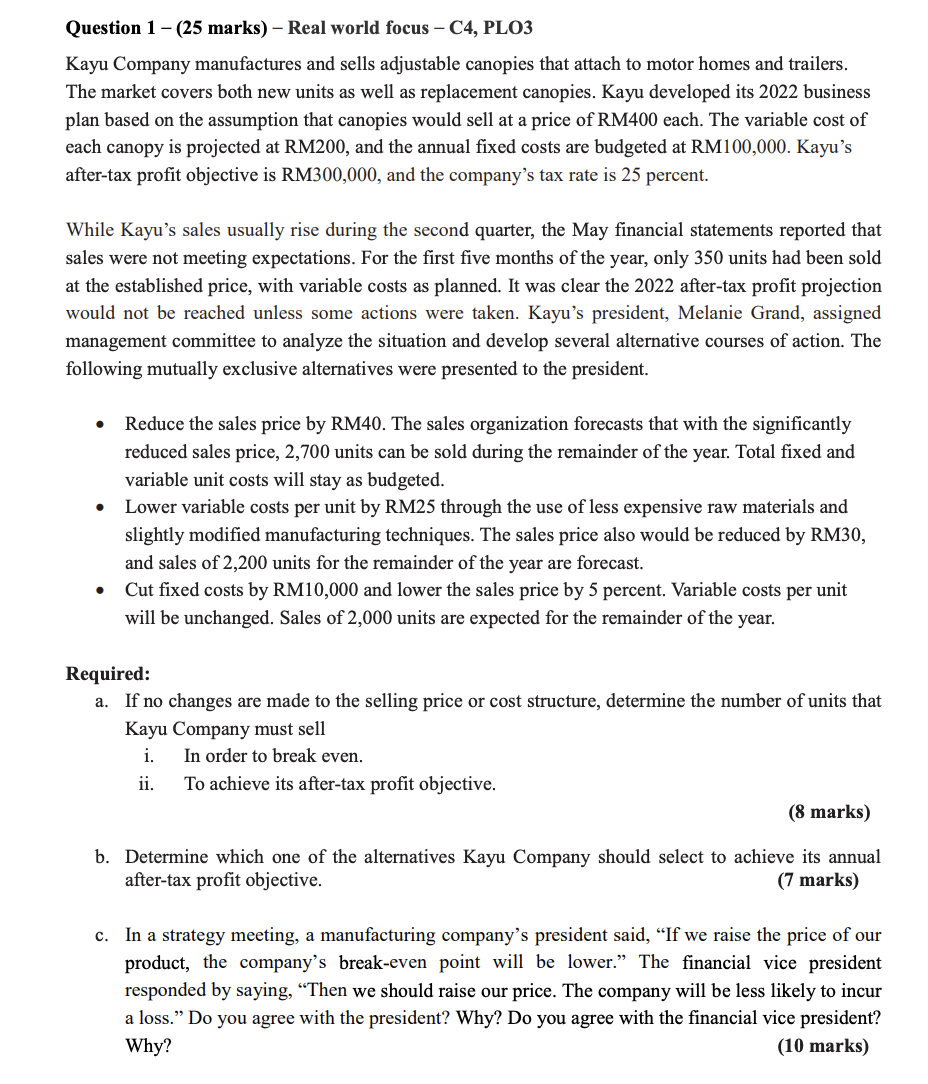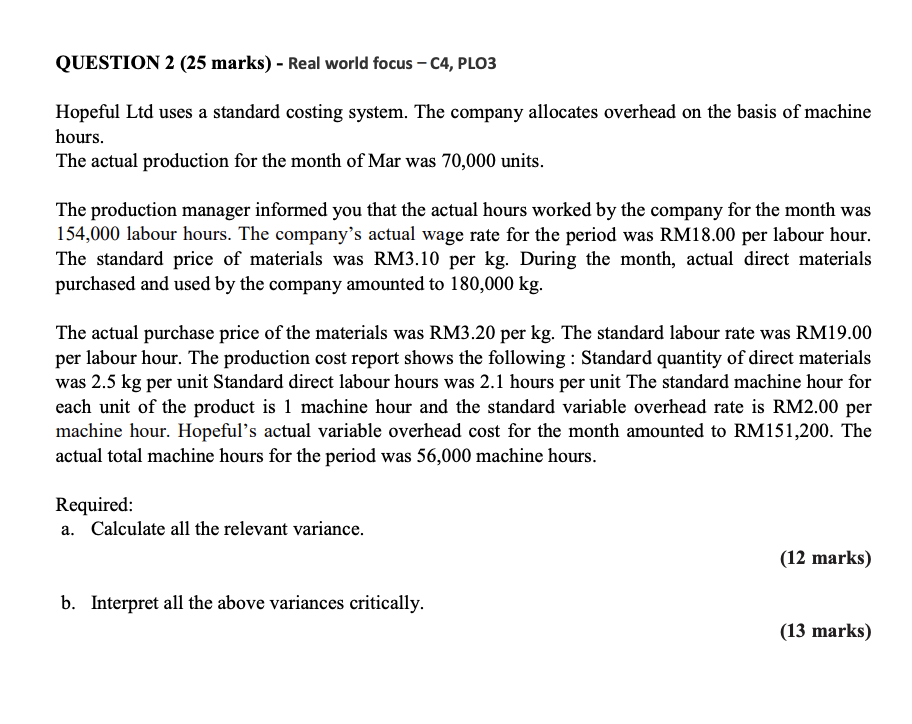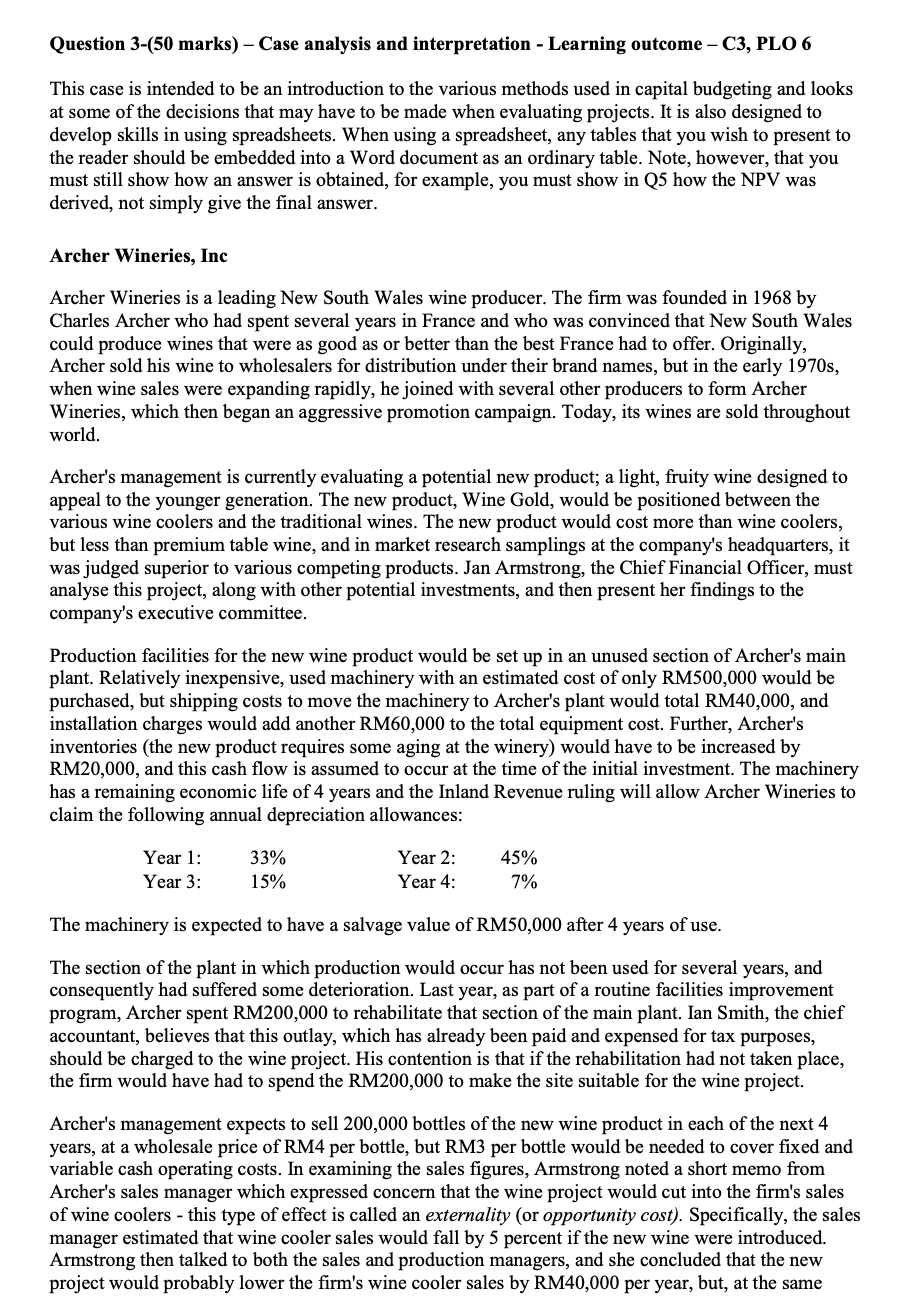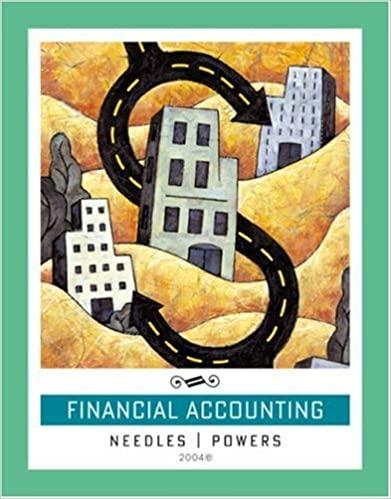Answered step by step
Verified Expert Solution
Question
1 Approved Answer
time, it would also reduce production costs for this product by RM20,000 per year, all on a pre-tax basis. Thus, the net externality effect would




 time, it would also reduce production costs for this product by RM20,000 per year, all on a pre-tax basis. Thus, the net externality effect would be -RM40,000 + RM20,000 =-RM20,000. Archer's effective tax rate is 40 percent, and its overall cost of capital is 10 percent. Now assume that you are Armstrong's assistant and she has asked you to analyse the project and then to present your findings in a 'tutorial' manner to Archer's executive committee. As Chief Financial Officer, Armstrong wants to educate some of the other executives, especially the marketing and sales managers, in the theory of capital budgeting so that these executives will have a better understanding of her capital budgeting decisions. Therefore, Armstrong wants you to ask and then answer a series of questions as set out below. Specifics on the other two projects that must be analysed are provided in Questions 4 and 5. Keep in mind that you will be questioned closely during your presentation, so you should understand every step of the analysis, including any assumptions and weaknesses that may be lurking in the background and that someone might spring on you in the meeting. Note: The WACC (Weighted Average Cost of Capital) of 10% is the appropriate discount rate to use when evaluating this project Question 1 - (25 marks) - Real world focus - C4, PLO3 Kayu Company manufactures and sells adjustable canopies that attach to motor homes and trailers. The market covers both new units as well as replacement canopies. Kayu developed its 2022 business plan based on the assumption that canopies would sell at a price of RM400 each. The variable cost of each canopy is projected at RM200, and the annual fixed costs are budgeted at RM100,000. Kayu's after-tax profit objective is RM300,000, and the company's tax rate is 25 percent. While Kayu's sales usually rise during the second quarter, the May financial statements reported that sales were not meeting expectations. For the first five months of the year, only 350 units had been sold at the established price, with variable costs as planned. It was clear the 2022 after-tax profit projection would not be reached unless some actions were taken. Kayu's president, Melanie Grand, assigned management committee to analyze the situation and develop several alternative courses of action. The following mutually exclusive alternatives were presented to the president. - Reduce the sales price by RM40. The sales organization forecasts that with the significantly reduced sales price, 2,700 units can be sold during the remainder of the year. Total fixed and variable unit costs will stay as budgeted. - Lower variable costs per unit by RM25 through the use of less expensive raw materials and slightly modified manufacturing techniques. The sales price also would be reduced by RM30, and sales of 2,200 units for the remainder of the year are forecast. - Cut fixed costs by RM10,000 and lower the sales price by 5 percent. Variable costs per unit will be unchanged. Sales of 2,000 units are expected for the remainder of the year. Required: a. If no changes are made to the selling price or cost structure, determine the number of units that Kayu Company must sell i. In order to break even. ii. To achieve its after-tax profit objective. (8 marks) b. Determine which one of the alternatives Kayu Company should select to achieve its annual after-tax profit objective. (7 marks) c. In a strategy meeting, a manufacturing company's president said, "If we raise the price of our product, the company's break-even point will be lower." The financial vice president responded by saying, "Then we should raise our price. The company will be less likely to incur a loss." Do you agree with the president? Why? Do you agree with the financial vice president? Why? (10 marks) Question 3-(50 marks) - Case analysis and interpretation - Learning outcome - C3, PLO 6 This case is intended to be an introduction to the various methods used in capital budgeting and looks at some of the decisions that may have to be made when evaluating projects. It is also designed to develop skills in using spreadsheets. When using a spreadsheet, any tables that you wish to present to the reader should be embedded into a Word document as an ordinary table. Note, however, that you must still show how an answer is obtained, for example, you must show in Q5 how the NPV was derived, not simply give the final answer. Archer Wineries, Inc Archer Wineries is a leading New South Wales wine producer. The firm was founded in 1968 by Charles Archer who had spent several years in France and who was convinced that New South Wales could produce wines that were as good as or better than the best France had to offer. Originally, Archer sold his wine to wholesalers for distribution under their brand names, but in the early 1970s, when wine sales were expanding rapidly, he joined with several other producers to form Archer Wineries, which then began an aggressive promotion campaign. Today, its wines are sold throughout world. Archer's management is currently evaluating a potential new product; a light, fruity wine designed to appeal to the younger generation. The new product, Wine Gold, would be positioned between the various wine coolers and the traditional wines. The new product would cost more than wine coolers, but less than premium table wine, and in market research samplings at the company's headquarters, it was judged superior to various competing products. Jan Armstrong, the Chief Financial Officer, must analyse this project, along with other potential investments, and then present her findings to the company's executive committee. Production facilities for the new wine product would be set up in an unused section of Archer's main plant. Relatively inexpensive, used machinery with an estimated cost of only RM500,000 would be purchased, but shipping costs to move the machinery to Archer's plant would total RM40,000, and installation charges would add another RM60,000 to the total equipment cost. Further, Archer's inventories (the new product requires some aging at the winery) would have to be increased by RM20,000, and this cash flow is assumed to occur at the time of the initial investment. The machinery has a remaining economic life of 4 years and the Inland Revenue ruling will allow Archer Wineries to claim the following annual depreciation allowances: The machinery is expected to have a salvage value of RM50,000 after 4 years of use. The section of the plant in which production would occur has not been used for several years, and consequently had suffered some deterioration. Last year, as part of a routine facilities improvement program, Archer spent RM200,000 to rehabilitate that section of the main plant. Ian Smith, the chief accountant, believes that this outlay, which has already been paid and expensed for tax purposes, should be charged to the wine project. His contention is that if the rehabilitation had not taken place, the firm would have had to spend the RM200,000 to make the site suitable for the wine project. Archer's management expects to sell 200,000 bottles of the new wine product in each of the next 4 years, at a wholesale price of RM4 per bottle, but RM3 per bottle would be needed to cover fixed and variable cash operating costs. In examining the sales figures, Armstrong noted a short memo from Archer's sales manager which expressed concern that the wine project would cut into the firm's sales of wine coolers - this type of effect is called an externality (or opportunity cost). Specifically, the sales manager estimated that wine cooler sales would fall by 5 percent if the new wine were introduced. Armstrong then talked to both the sales and production managers, and she concluded that the new project would probably lower the firm's wine cooler sales by RM40,000 per year, but, at the same a. Solve the following (10 marks) i. Define the term 'incremental cash flow'. Since the project will be financed in part by debt, should the cash flow statement include interest expenses? Explain. ii. Should the RM200,000 that was spent to rehabilitate the plant be included in the analysis? Explain. iii. Suppose another wine maker had expressed an interest in leasing the wine production site for RM10,000 a year. If this were true (in fact it was not), how should that information be incorporated into the analysis? b. Complete Tables 1 and 2 and determine the cash flows for the projects. (15 marks) c. Using the relevant cash flows identified in Tables 1 and 2, calculate the projects: i.Net Present Value (NPV) ii.Internal Rate of Return (IRR) iii.Payback Period iv. Will you recommend that the project should be undertaken? Why or why not? (15 marks) d. The second capital budgeting decision which Armstrong and you were asked to analyse involves choosing between two mutually exclusive projects, S and L, whose cash flows are set forth below: Both of these projects are in Archer's main line of business, premium table wine, and the investment which is chosen is expected to be repeated indefinitely into the future. Also, each project is of average risk, and hence each is assigned the 10% required rate of return. What is each project's single cycle NPV? Can you make a decision on this information? Why or why not? If not, what should you do to be able to make a decision? Which project should be chosen? Why? QUESTION 2 (25 marks) - Real world focus - C4, PLO3 Hopeful Ltd uses a standard costing system. The company allocates overhead on the basis of machine hours. The actual production for the month of Mar was 70,000 units. The production manager informed you that the actual hours worked by the company for the month was 154,000 labour hours. The company's actual wage rate for the period was RM18.00 per labour hour. The standard price of materials was RM3.10 per kg. During the month, actual direct materials purchased and used by the company amounted to 180,000kg. The actual purchase price of the materials was RM3.20 per kg. The standard labour rate was RM19.00 per labour hour. The production cost report shows the following: Standard quantity of direct materials was 2.5kg per unit Standard direct labour hours was 2.1 hours per unit The standard machine hour for each unit of the product is 1 machine hour and the standard variable overhead rate is RM2.00 per machine hour. Hopeful's actual variable overhead cost for the month amounted to RM151,200. The actual total machine hours for the period was 56,000 machine hours. Required: a. Calculate all the relevant variance. (12 marks) b. Interpret all the above variances critically. (13 marks)
time, it would also reduce production costs for this product by RM20,000 per year, all on a pre-tax basis. Thus, the net externality effect would be -RM40,000 + RM20,000 =-RM20,000. Archer's effective tax rate is 40 percent, and its overall cost of capital is 10 percent. Now assume that you are Armstrong's assistant and she has asked you to analyse the project and then to present your findings in a 'tutorial' manner to Archer's executive committee. As Chief Financial Officer, Armstrong wants to educate some of the other executives, especially the marketing and sales managers, in the theory of capital budgeting so that these executives will have a better understanding of her capital budgeting decisions. Therefore, Armstrong wants you to ask and then answer a series of questions as set out below. Specifics on the other two projects that must be analysed are provided in Questions 4 and 5. Keep in mind that you will be questioned closely during your presentation, so you should understand every step of the analysis, including any assumptions and weaknesses that may be lurking in the background and that someone might spring on you in the meeting. Note: The WACC (Weighted Average Cost of Capital) of 10% is the appropriate discount rate to use when evaluating this project Question 1 - (25 marks) - Real world focus - C4, PLO3 Kayu Company manufactures and sells adjustable canopies that attach to motor homes and trailers. The market covers both new units as well as replacement canopies. Kayu developed its 2022 business plan based on the assumption that canopies would sell at a price of RM400 each. The variable cost of each canopy is projected at RM200, and the annual fixed costs are budgeted at RM100,000. Kayu's after-tax profit objective is RM300,000, and the company's tax rate is 25 percent. While Kayu's sales usually rise during the second quarter, the May financial statements reported that sales were not meeting expectations. For the first five months of the year, only 350 units had been sold at the established price, with variable costs as planned. It was clear the 2022 after-tax profit projection would not be reached unless some actions were taken. Kayu's president, Melanie Grand, assigned management committee to analyze the situation and develop several alternative courses of action. The following mutually exclusive alternatives were presented to the president. - Reduce the sales price by RM40. The sales organization forecasts that with the significantly reduced sales price, 2,700 units can be sold during the remainder of the year. Total fixed and variable unit costs will stay as budgeted. - Lower variable costs per unit by RM25 through the use of less expensive raw materials and slightly modified manufacturing techniques. The sales price also would be reduced by RM30, and sales of 2,200 units for the remainder of the year are forecast. - Cut fixed costs by RM10,000 and lower the sales price by 5 percent. Variable costs per unit will be unchanged. Sales of 2,000 units are expected for the remainder of the year. Required: a. If no changes are made to the selling price or cost structure, determine the number of units that Kayu Company must sell i. In order to break even. ii. To achieve its after-tax profit objective. (8 marks) b. Determine which one of the alternatives Kayu Company should select to achieve its annual after-tax profit objective. (7 marks) c. In a strategy meeting, a manufacturing company's president said, "If we raise the price of our product, the company's break-even point will be lower." The financial vice president responded by saying, "Then we should raise our price. The company will be less likely to incur a loss." Do you agree with the president? Why? Do you agree with the financial vice president? Why? (10 marks) Question 3-(50 marks) - Case analysis and interpretation - Learning outcome - C3, PLO 6 This case is intended to be an introduction to the various methods used in capital budgeting and looks at some of the decisions that may have to be made when evaluating projects. It is also designed to develop skills in using spreadsheets. When using a spreadsheet, any tables that you wish to present to the reader should be embedded into a Word document as an ordinary table. Note, however, that you must still show how an answer is obtained, for example, you must show in Q5 how the NPV was derived, not simply give the final answer. Archer Wineries, Inc Archer Wineries is a leading New South Wales wine producer. The firm was founded in 1968 by Charles Archer who had spent several years in France and who was convinced that New South Wales could produce wines that were as good as or better than the best France had to offer. Originally, Archer sold his wine to wholesalers for distribution under their brand names, but in the early 1970s, when wine sales were expanding rapidly, he joined with several other producers to form Archer Wineries, which then began an aggressive promotion campaign. Today, its wines are sold throughout world. Archer's management is currently evaluating a potential new product; a light, fruity wine designed to appeal to the younger generation. The new product, Wine Gold, would be positioned between the various wine coolers and the traditional wines. The new product would cost more than wine coolers, but less than premium table wine, and in market research samplings at the company's headquarters, it was judged superior to various competing products. Jan Armstrong, the Chief Financial Officer, must analyse this project, along with other potential investments, and then present her findings to the company's executive committee. Production facilities for the new wine product would be set up in an unused section of Archer's main plant. Relatively inexpensive, used machinery with an estimated cost of only RM500,000 would be purchased, but shipping costs to move the machinery to Archer's plant would total RM40,000, and installation charges would add another RM60,000 to the total equipment cost. Further, Archer's inventories (the new product requires some aging at the winery) would have to be increased by RM20,000, and this cash flow is assumed to occur at the time of the initial investment. The machinery has a remaining economic life of 4 years and the Inland Revenue ruling will allow Archer Wineries to claim the following annual depreciation allowances: The machinery is expected to have a salvage value of RM50,000 after 4 years of use. The section of the plant in which production would occur has not been used for several years, and consequently had suffered some deterioration. Last year, as part of a routine facilities improvement program, Archer spent RM200,000 to rehabilitate that section of the main plant. Ian Smith, the chief accountant, believes that this outlay, which has already been paid and expensed for tax purposes, should be charged to the wine project. His contention is that if the rehabilitation had not taken place, the firm would have had to spend the RM200,000 to make the site suitable for the wine project. Archer's management expects to sell 200,000 bottles of the new wine product in each of the next 4 years, at a wholesale price of RM4 per bottle, but RM3 per bottle would be needed to cover fixed and variable cash operating costs. In examining the sales figures, Armstrong noted a short memo from Archer's sales manager which expressed concern that the wine project would cut into the firm's sales of wine coolers - this type of effect is called an externality (or opportunity cost). Specifically, the sales manager estimated that wine cooler sales would fall by 5 percent if the new wine were introduced. Armstrong then talked to both the sales and production managers, and she concluded that the new project would probably lower the firm's wine cooler sales by RM40,000 per year, but, at the same a. Solve the following (10 marks) i. Define the term 'incremental cash flow'. Since the project will be financed in part by debt, should the cash flow statement include interest expenses? Explain. ii. Should the RM200,000 that was spent to rehabilitate the plant be included in the analysis? Explain. iii. Suppose another wine maker had expressed an interest in leasing the wine production site for RM10,000 a year. If this were true (in fact it was not), how should that information be incorporated into the analysis? b. Complete Tables 1 and 2 and determine the cash flows for the projects. (15 marks) c. Using the relevant cash flows identified in Tables 1 and 2, calculate the projects: i.Net Present Value (NPV) ii.Internal Rate of Return (IRR) iii.Payback Period iv. Will you recommend that the project should be undertaken? Why or why not? (15 marks) d. The second capital budgeting decision which Armstrong and you were asked to analyse involves choosing between two mutually exclusive projects, S and L, whose cash flows are set forth below: Both of these projects are in Archer's main line of business, premium table wine, and the investment which is chosen is expected to be repeated indefinitely into the future. Also, each project is of average risk, and hence each is assigned the 10% required rate of return. What is each project's single cycle NPV? Can you make a decision on this information? Why or why not? If not, what should you do to be able to make a decision? Which project should be chosen? Why? QUESTION 2 (25 marks) - Real world focus - C4, PLO3 Hopeful Ltd uses a standard costing system. The company allocates overhead on the basis of machine hours. The actual production for the month of Mar was 70,000 units. The production manager informed you that the actual hours worked by the company for the month was 154,000 labour hours. The company's actual wage rate for the period was RM18.00 per labour hour. The standard price of materials was RM3.10 per kg. During the month, actual direct materials purchased and used by the company amounted to 180,000kg. The actual purchase price of the materials was RM3.20 per kg. The standard labour rate was RM19.00 per labour hour. The production cost report shows the following: Standard quantity of direct materials was 2.5kg per unit Standard direct labour hours was 2.1 hours per unit The standard machine hour for each unit of the product is 1 machine hour and the standard variable overhead rate is RM2.00 per machine hour. Hopeful's actual variable overhead cost for the month amounted to RM151,200. The actual total machine hours for the period was 56,000 machine hours. Required: a. Calculate all the relevant variance. (12 marks) b. Interpret all the above variances critically. (13 marks) Step by Step Solution
There are 3 Steps involved in it
Step: 1

Get Instant Access to Expert-Tailored Solutions
See step-by-step solutions with expert insights and AI powered tools for academic success
Step: 2

Step: 3

Ace Your Homework with AI
Get the answers you need in no time with our AI-driven, step-by-step assistance
Get Started


